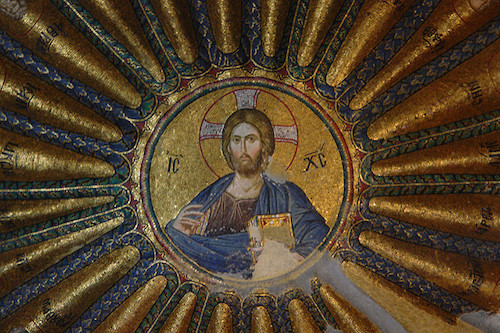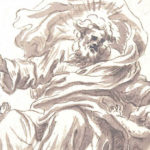We run our website the way we wished the whole internet worked: we provide high quality original content with no ads. We are funded solely by your direct support. Please consider supporting this project.

Modern Theologians and the Centrality of Christ
During the twentieth century the development of a Christocentric reading of the Scriptures—which is crucial to understanding what I argue in Crucifixion of the Warrior God—surged in the wake of Karl Barth’s publication of his Romans commentary in 1916. It was justifiably described as a “bombshell” that fell “on the playground of the theologians,” demolishing the anthropocentric and rationalistic approaches of 19th century liberal theology and replacing it with a relentless and all-encompassing Christocentric focus.
Thereafter, an ever-increasing number of theologians from a variety of traditions have espoused theologies that could be broadly classified as “Christocentric.” And the last several decades have witnessed a virtual explosion of works in hermeneutics, homiletics, and systematic theology that have been categorized as Christocentric. To illustrate this Christocentric orientation among recent theologians and biblical interpreters, it seems appropriate to begin with my former professor at Yale, Brevard Childs. This pioneer in the field of biblical theology held that Christ is “the subject matter, substance, or res” of all Scripture. For this reason, he argued, the “fundamental goal” of biblical theology must be “to understand the various voices within the whole Christian Bible, New and Old Testament alike, as a witness to the one Lord Jesus Christ…”[1]
Arguing along similar lines, Leonhard Goppelt eloquently portrays Jesus as the “the focal point” of Scripture “that gathers all the rays of light that issue from Scripture.”[2] Peter Leithart holds that “Scripture is about Christ,” adding that “[t]he Christ who is the subject matter of Scripture is the totus Christus,” while Scott Swain has recently pointed out that even with all of its remarkable diversity, “God speaks the same Word” throughout Scripture, and that word is “Christ.”[3] All the literary forms of Scripture, he contends, “constitute a harmonious witness to the glory of the Word made flesh.”[4] Vern Poythress poignantly reflects the same orientation when he contends that “[t]he alternative to a Christocentric understanding of the Old Testament is not understanding it rightly…”[5]
In the same vein, Treier sums the conviction of most who comprise the Theological Interpretation of Scripture (TIS) movement—which I employ in Crucifixion of the Warrior God—over the last two decades when he states that, “whether one is reading the Gospels or … the Old Testament … all Scripture requires interpretation with the reality of Jesus Christ as the center of its narrative world.”[6] Similarly, Miroslav Volf writes: “For Christians, Jesus Christ is the content of the Bible, and just for that reason the Bible is the site of God’s self-revelation.”[7]
Nor is this revival of Christocentric hermeneutics a strictly Protestant phenomenon. There could be no better representative of a Christocentric approach to Scripture than Pope Benedict when he boldly states that “Christ is the key to all things …. [O]nly … by reinterpreting all things in his light, with him, crucified and risen, do we enter into the riches and beauty of sacred Scripture.”[8]
Yet, so far as I can see, no contemporary scholars go further in reflecting an intense and consist consistent Christocentric orientation than Thomas Torrance and Graeme Goldsworthy. Torrance exemplified an approach to Scripture that was “deeply and carefully Christological” and that emphatically displayed the conviction that “the heart of Scripture is Jesus Christ.”[9] Christ was for Torrance “the living text we read in the Bible.”[10] The most fundamental challenge for all theological interpreters of Scripture, therefore, is to “interpret it in terms of its scopus or goal, Jesus Christ, thus seeing it in its relation of depth with its truth in his incarnate person.”[11]
Similarly, Goldsworthy has consistently maintained that the most fundamental presupposition for Christian interpreters of Scripture must be that “… all texts in the whole Bible bear a discernible relationship to Christ and are primarily intended as a testimony to Christ.”[12] Goldsworthy has argued that if Jesus is “the one mediator between God and man,” then he must function as “the hermeneutic principle for every word from God.”[13] Hence, Goldsworthy has concluded, “the prime question to put to every text is about how it testifies to Jesus.” [14]
In fact, Goldsworthy and Torrance along with several others have argued that, as the mediator, redeemer, head and goal of all creation, Jesus must be regarded as the hermeneutical key not only to all Scripture but to all reality.[15]
[1] B. Childs, Biblical Theology of the Old and New Testaments, 80, 85.
[2] L. Goppelt, Typos: The Typological Interpretation of the Old Testament in the New, 58;
[3] P. J. Leithart, Deep Exegesis: The Mystery of Reading Scripture, 173; S. Swain, Trinity, Revelation and Reading, 25.
[4] Swain, ibid., 60.
[5] Poythress, God-Centered, 60.
[6] Treier, Introducing Theological Interpretation of Scripture, 67.
[7] M. Volf, “Reading the Bible Theologically,” in Captive to the Word of God: Engaging the Scriptures for Contemporary Theological Reflection, 6.
[8] Quoted in S. W. Hahn, Covenant and Communion: The Biblical Theology of Pope Benedict XVI, 82.
[9] T. Torrance, Atonement: The Person and Work of Christ, lix.
[10] Op. cit. xxx.
[11] Torrance, Atonement, xxxiii
[12] Goldsworthy, Preaching the Whole Bible, 113
[13] Goldsworthy, Gospel-Centered Hermeneutics, 21. See Torrance, Atonement xxx.
[14] Goldsworthy, Gospel-Centered Hermeneutics, 21.
[15] Goldsworthy, ibid., 251.
Photo credit: CharlesFred via VisualHunt.com / CC BY-NC-SA
Category: General
Tags: Bible Interpretation, Christocentrism, Crucifixion of the Warrior God, Cruciform Theology, Theology
Topics: Biblical Interpretation
Related Reading

Would God Kill a Baby To Teach Parents a Lesson?
Question: We have a group of guys that are going through your book “Is God to Blame” and a question came up that I would be curious how you would look at it. In the beginning of the book you ask the question “do you really think that God kills babies to teach parents a lesson?”…

Paul’s Blinding of Elymas: A Response to Paul Copan (#5)
In the first four posts in this “Response to Copan” series, I attempted to refute Copan’s claim that my non-violent understanding of love, as advocated in Crucifixion of the Warrior God (CWG) and Cross Vision (CV), conflicts with Paul’s quotation of violent Psalms, the praising of the faith of warriors in Hebrews 11:30-32, the longing…

Rethinking the Resurrection
As much as every other aspect of Jesus life and ministry, I submit that the resurrection must be understood in light of the cross. This event was not anything like the resuscitation of a random corpse. It was the resurrection of the Incarnate Son of God who had fulfilled the human side of the God-human…

A Cruciform Magic Eye
In this post I’d like to share the story of how I came upon the thesis I’m defending in the book I’ve been working on for the last four years entitled The Crucifixion of the Warrior God: A Cruciform Theological Interpretation of the Old Testament’s Violent Divine Portraits. It’s a much longer post than usual,…

Jesus, the Word of God
“[T]he standing message of the Fathers to the Church Universal,” writes Georges Florovsky, was that “Christ Jesus is the Alpha and Omega of the Scriptures both the climax and the knot of the Bible.”[1] It was also unquestionably one of the most foundational theological assumptions of Luther and Calvin as well as other Reformers. Hence,…

Podcast: Isn’t God Withdrawing the SAME as Him Personally Punishing and Causing Violence?
Greg discusses whether the passivity of withdrawal is distinguishable from active punishment. http://traffic.libsyn.com/askgregboyd/Episode_0186.mp3
